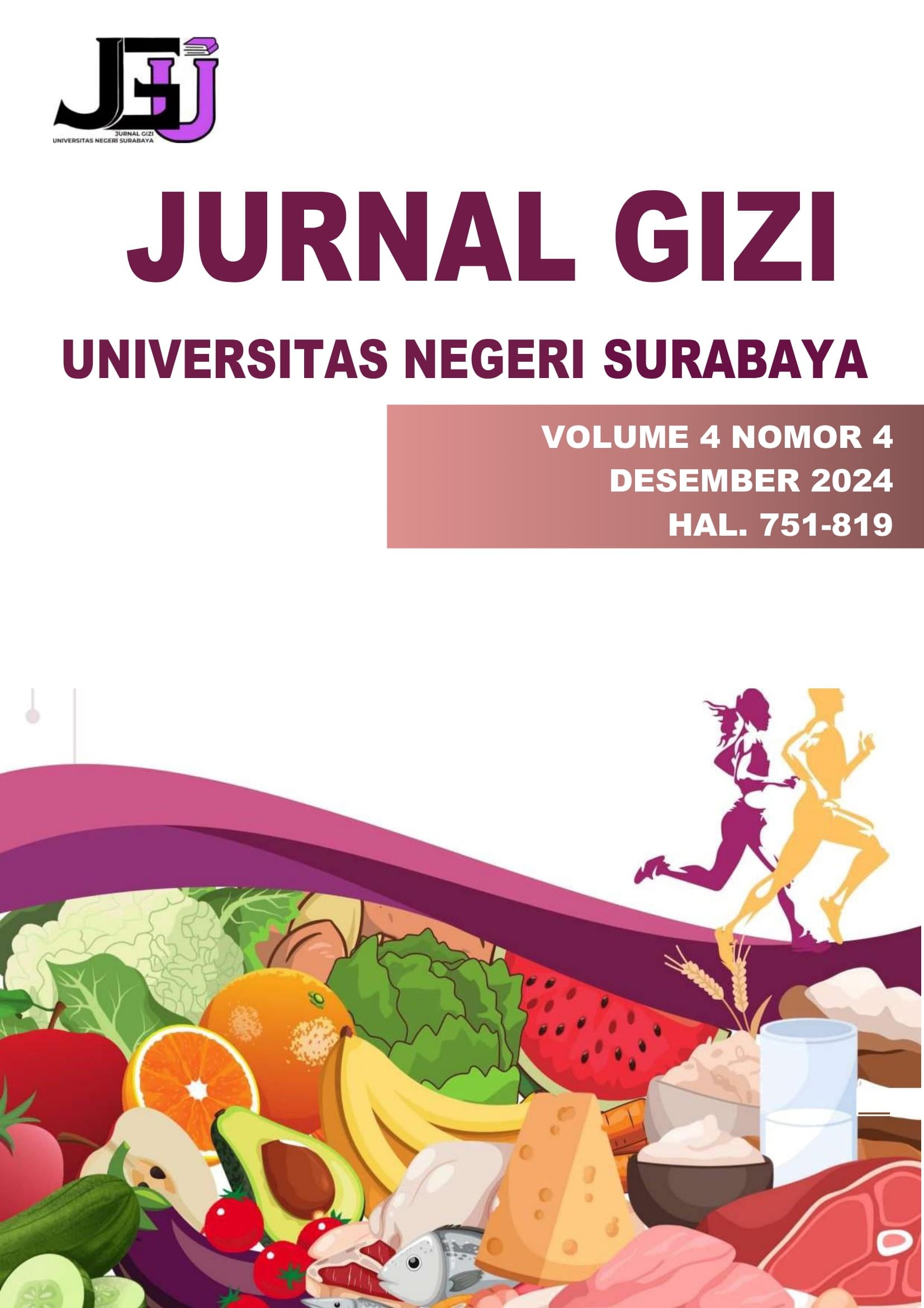Descriptions of Macronutrients Consumption and Nutritional Status in Women of Childbearing Age with Polycystic Ovary Syndrome in Surabaya
Keywords:
polycystic ovary syndrome, macronutrients, nutritional status, women of childbearing ageAbstract
Polycystic ovary syndrome is a hormonal disorder commonly found in the female reproductive sistem with a prevalence of 4-10% worldwide. Women with PCOS generally exhibit increased appetite, have a preference for high glycemic index foods, and tend to consume protein in larger amounts. The purpose of this study was to determine the description of macronutrient consumption and nutritional status in women of childbearing age with polycystic ovary syndrome in Surabaya. This study is a descriptinve quantitative study. The respondents in this study were 16 women aged 23-30 years with polycystic ovary syndrome who live in the city of Surabaya. The data obtained are primary data obtained from the Semi-Quantitative Food Frequency Questionnare (SQ-FFQ) questionnare and the respondents Body Mass Indeks. Data analysis used univariate tests status in women of childbearing age with polycystic ovary syndrome. The results of this study indicate that the carbohydrate intake of the majority of respondents has not reached the recommended carbohydrate needs. The fat intake of the majority of respondents exceeds the recommended fat needs. The protein intake of the majority of respondents exceeds the recommendes protein needs. The nutritional status of respondents shows a BMI of 50% normal, 6.25% overweight dan 43.75% obesity.
Downloads
References
Hestiantoro, A., Wiweko, B., Harzif, A. kemal, Shadrina, A., Rahayu, D., & Silvia, M. (2016). Konsensus Tata Laksana Sindrom Ovarium Polikistik. Himpunan Endokrinologi Reproduksi Dan Fertilitas Indonesia (HIFERI) Perkumpulan Obstetri Dan Ginekologi Indonesia (POGI), 79.
Irene, A., Alkaf, S., Zulissetiana, E. F., Usman, F., & Larasaty, V. (2020). Hubungan Pola Makan dengan Risiko Terjadinya Sindrom Ovarium Polikistik pada Remaja. Sriwijaya Journal of Medicine, 3(1), 65–72. https://doi.org/10.32539/sjm.v3i1.141
Jupri, E., Tjandrawati, A., Bayuaji, H., Rachmayati, S., & Parwati, I. (2019). Correlation between Body Mass Index and Serum Leptin Level in Patients with Polycystic Ovary Syndrome. Majalah Kedokteran Bandung, 51(3), 154–159. https://doi.org/10.15395/mkb.v51n3.1459
Kurniawati, E. Y., Hadisaputro, S., & Suwandono, A. (2022). STATUS GIZI WANITA DENGAN SINDROM OVARIUM POLIKISTIK (SOPK). Jurnal Ilmu Kebidanan, 8(1). https://doi.org/10.48092/jik.v8i1.164
Mareta, R., Amran, R., Larasati, V., Studi Pendidikan Dokter, P., Kedokteran, F., Sriwijaya, U., Moh Ali Komp RSMH Km, J., Fertilitas Endokrinologi Reproduksi, B., Obstetri dan Ginekologi RSUP drMohammad Hoesin Palembang, D., Jend Sudirman Km, J., & Histologi Fakultas Kedokteran, B. (2018). Hubungan Polycystic Ovary Syndrome(PCOS)dengan Infertilitas di Praktik Swasta Dokter ObstetriGinekologi Palembang.
Maulitanti, S. D., Marlina, U., Annisa, Y., & Masitha, D. (2023). Pengaruh Penerapan Diet Anti Inflamasi Pada Perubahan Manifestasi Klinis Dan Penanda Inflamasi Wanita Dengan Polycystic Ovary Syndrome (PCOS). Jurnal Pendidikan Indonesia, 4(05). https://doi.org/10.59141/japendi.v4i05.1821
Singh, A., Vijaya, K., & Sai Laxmi, K. (2018). Prevalence of polycystic ovarian syndrome among adolescent girls: a prospective study. International Journal of Reproduction, Contraception, Obstetrics and Gynecology, 7(11), 4375. https://doi.org/10.18203/2320-1770.ijrcog20184230
Wahyuni, A., Supriyatiningsih, Kusumawati, W., Kirana, K., & Mayayustika, C. (2022). Family History of PCOS, Obesity, Low Fiber Diet, and Low Physical Activity Increase The Risk of PCOS. Indonesian Journal of Medicine and Health, 13(1), 50–56. https://doi.org/10.20885/JKKI.Vol13.Iss1.art8
Yuniarti, H. (2023). INTERVENSI NUTRISI PADA PENDERITA PCOS.
Downloads
Published
How to Cite
Issue
Section
 Abstract views: 180
,
Abstract views: 180
, PDF Downloads: 177
PDF Downloads: 177


